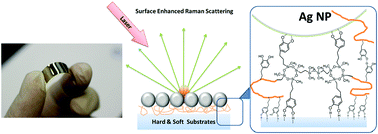A versatile platform of catechol-functionalized polysiloxanes for hybrid nanoassembly and in situ surface enhanced Raman scattering applications†
Abstract
Inspired by the marine mussel strategy of adhesion in aqueous environments, catechol-functionalized polysiloxane (CFPS) was synthesized. Facile dip-coating showed good film forming ability on various organic and inorganic substrates with a surface roughness of 4.6 nm (50 μm × 50 μm). Silver nanoparticles (AgNPs) are anchored onto CFPS-modified substrates using a dip coating process. The scanning electron microscopy images revealed that AgNPs were distributed homogeneously on numerous substrates. Moreover, the surface number density and average interspace of the AgNPs were tuned easily by controlling the concentration of AgNP dispersions. A substrate with high-density AgNPs exhibited excellent surface enhanced Raman scattering (SERS) performance with an enhancement factor as high as 7.89 × 107 and an ultra-low detection limitation of 10−10 M, which can be ascribed to the “hotspots” formed between the adjacent AgNPs controlled by CFPS-induced self-assembly. The AgNP structures prepared on different substrates modified using CFPS show a similar high intensity, suggesting a versatile platform of the CFPS film for AgNP assemblies. In addition, AgNPs were anchored to be extremely stable on substrates because of strong hydrogen bonding interactions provided by the high surface-density catechol units of CFPS, which made the substrate a promising SERS sensor for practical applications. In situ SERS detection was also demonstrated on apple peel with no damage to AgNP structures.


 Please wait while we load your content...
Please wait while we load your content...